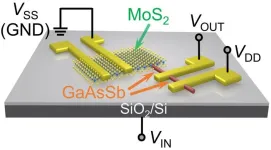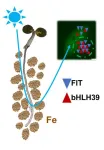(Press-News.org) A new study identified a set of 140 genes that may help predict enhanced disease-free survival in patients with non-small cell lung cancer (NSCLC) treated with a combination of immunotherapy and low-dose radiation. The results, published in Cell Reports Medicine on Feb. 23, suggested that this “gene signature” could be used to identify a subclass of lung tumors that is more likely to be eradicated by immunotherapies.
Immunotherapy has saved countless lives but only 20 to 25 percent of patients respond to this treatment that activates a person’s own immune system to attack their cancer. Predicting who would benefit from this approach and why could help patients who have exhausted other options such as chemotherapy.
Studying a cohort of 60 patients with NSCLC, the team determined previously that adding a low dose of radiation to a course of durvalumab, an immune-boosting drug, promoted cancer-free survival in most of these individuals. Now, to assess why some tumors didn’t respond to the therapy, the researchers examined pretreatment tumor biopsies from this study cohort. They determined the gene expression profiles, which showed the specific genes that are turned up and those that turned down in each sample.
They compared the gene expression profiles of ten tumors that reached major pathologic response (MPR)—the elimination of more than 90 percent of the cancer cells in patients’ tumors—with combination treatment versus six that did not. They discovered the two groups of pretreatment tumors could be reliably distinguished by a set of genes with 135 of the genes turned up and 5 turned down. The majority of the 135 genes were associated with enhanced cell growth, suggesting the tumors that responded to the dual therapy were particularly aggressive.
The researchers were also able to examine how the gene expression profile changed in the responsive cancers before and after treatment. They found that in tumors displaying MPR, dual therapy not only reversed the activity of this 140-gene set, it also increased the activation of genes associated with cellular pathways involved in immunity and tissue repair.
The activity of the 140 genes which correlated with treatment response is particularly promising as clinicians could use the signature to identify people who would gain the maximum benefit from immunotherapy.
The researchers plan to test whether tumors with this aggressive gene signature have a better response to the combination therapy in a larger patient study.
Corresponding authors:
Dr. Nasser Altorki
Dr. Timothy McGraw
END
Genetic signature may predict response to immunotherapy for non-small cell lung cancer
2024-02-23
ELSE PRESS RELEASES FROM THIS DATE:
A study by the UMA and the University of California analyzes how lies affect economic decisions
2024-02-23
Psychology and Economics come together in a recent line of research, led by Ismael Rodríguez-Lara, Professor at the University of Malaga, who studies how lies affect economic decisions.
It is a study developed together with the Professor at the University of California (Santa Barbara, USA) Gary Charness, considered one of the most influential economists in the world within the experimental area, that has analyzed the way in which morality influences the degree of lying in certain economic situations. The results of this research have been published in the scientific journal Economics ...
Navigating the depths: Exploration in underwater navigation using acoustic beacons
2024-02-23
New exploration in underwater navigation, a team from the Naval University of Engineering in Wuhan, China, has created novel algorithms that rectify inertial errors using sparse acoustic signals. This exploration offers novel method for the issue of underwater navigation , where traditional satellite systems are ineffective due to their signals' inability to penetrate water effectively.
The increasing demand for precise underwater Positioning, Navigation, and Timing (PNT) due to expanding marine exploration and activities highlights the limitations of traditional Global Satellite Navigation Systems (GNSS) ...
Shaping the future: A new technique for sorting micro-particles unveiled
2024-02-23
Thanks to the rapid progress in tiny tech, we've been mainly using microfluidics to sort tiny particles by size. But now, there's a new way to sort them by shape, which could be a big deal for medical tests and chemistry. This study shows off a new method using sound waves to separate oddly shaped particles from round ones, without needing any labels. This breakthrough could lead to better ways to deliver drugs or diagnose diseases by offering a smarter approach to sort these tiny particles.
In the realm of microfluidics, separating micro-particles based solely on size has been the norm. However, distinguishing these particles ...
Mixed-dimensional transistors enable high-performance multifunctional electronic devices
2024-02-23
Downscaling of electronic devices, such as transistors, has reached a plateau, posing challenges for semiconductor fabrication. However, a research team led by materials scientists from City University of Hong Kong (CityUHK) recently discovered a new strategy for developing highly versatile electronics with outstanding performance, using transistors made of mixed-dimensional nanowires and nanoflakes. This innovation paves the way for simplified chip circuit design, offering versatility and low power dissipation in future electronics.
In recent decades, as ...
Biomolecular condensates – regulatory hubs for plant iron supply
2024-02-23
Iron is a micronutrient for plants. Biologists from the Institute of Botany at Heinrich Heine University Düsseldorf (HHU) describe in a study, which has now been published in the Journal of Cell Biology, that regulatory proteins for iron uptake behave particularly dynamically in the cell nucleus when the cells are exposed to blue light – an important signal for plant growth. They found that the initially homogeneously distributed proteins relocated together into “biomolecular condensates” in the cell nucleus shortly after this exposure.
Both iron deficiencies and excesses are problematic for plants. They ...
PolyU researchers introduce biomineralization as a sustainable strategy against microbial corrosion in marine concrete
2024-02-23
Microbially induced corrosion (MIC) is a prevalent issue in marine environments, leading to structural damages such as cracking in concrete infrastructure. This corrosion poses a persistent challenge, significantly reducing the lifespan of marine structures and resulting in substantial economic losses. In response to the need for an effective solution to combat the marine corrosion on concrete, researchers of the Hong Kong Polytechnic University have developed a biomineralization approach to protect marine concrete from MIC.
Prof. ...
Genes affect your blood pressure from early childhood
2024-02-23
Certain genes associated with hypertension affect blood pressure from early in life, and they increase the risk of cardiovascular disease as you get older. However, you can do something about it.
“We are talking about really small differences, so small that they may fall within what is considered normal blood pressure. The problem is that they tend to last your whole life,” says PhD Candidate Karsten Øvretveit at the Norwegian University of Science and Technology's (NTNU) Department of ...
Streams connected to groundwater show improved detoxification and microbial diversity
2024-02-23
Washington, D.C. — Feb. 23, 2024 —Streams with ample connections to shallow groundwater flowpaths have greater microbial diversity and are more effective at preventing toxic forms of metals—often products of upstream mining—from entering and being transported downstream. These streams are also better at detoxifying those metals already present. The research is published this week in Applied and Environmental Microbiology, a journal of the American Society for Microbiology.
Under favorable conditions, the zone lining a stream channel stores nutrients and oxygen that meet nutritional and respiratory needs of local invertebrates and fish. That ...
Almodóvar receives NIH grant to study pulmonary hypertension in HIV patients
2024-02-23
Across the globe, more than 39 million people are living with the Human Immunodeficiency Virus (HIV), the virus that causes AIDS, including more than 1.3 million new HIV diagnoses last year. The majority of those afflicted — approximately 76% — have access to antiviral therapy that allows them to live with HIV as a chronic disease.
Sharilyn Almodóvar, Ph.D., from the Department of Immunology and Molecular Microbiology at the Texas Tech University Health Sciences Center (TTUHSC) School of Medicine and the TTUHSC Graduate School of Biomedical Sciences, said that even with the widespread ...
SK bioscience’s typhoid conjugate vaccine achieves WHO prequalification
2024-02-23
WHO PQ paves the way for public procurement of SKYTyphoid™ by UN organizations
Addition of new vaccine will diversify, expand TCV supply amid expected growing demand
February 23, 2024, SEOUL, Korea – SK bioscience and the International Vaccine Institute (IVI) announced today that the typhoid conjugate vaccine developed by SK bioscience with technology transfer from IVI has achieved the World Health Organization prequalification (PQ), which paves the way for public procurement of the vaccine by UN organizations and gives a boost to the global TCV supply.
WHO PQ certifies the safety, efficacy, and GMP of a vaccine by evaluating its manufacturing ...






